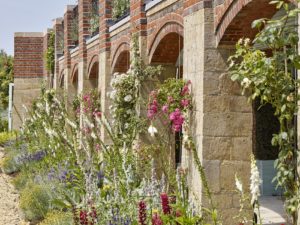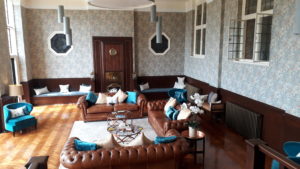Learn about the history of King Edward VII Estate
July 23, 2019
Opened as a Tuberculosis Sanatorium by King Edward VII in 1906, the historic buildings and gardens of the King Edward VII Hospital were considered a masterpiece in Arts and Crafts design.
Until recently, the last 100 years had left their mark on this magnificent building, with various modern buildings being added, eroding the symmetry and elegance of the original architecture.
Following planning consent granted by the South Downs National Park Authority, Developer City & Country has removed these modern additions and restored the Sanatorium to its former glory while creating a collection of beautiful apartments and communal areas.
Work continues on the housing development, with construction and conversion work on the north west wing set to be completed in the autumn.
City & Country will be opening the doors of the Estate this September 19th as part of Heritage Open Days. Those lucky enough to secure a ticket will enjoy a tour around the historic buildings and gardens of King Edward VII Estate and learn about the fascinating history of the building and landscapes.
For more details and to book on to the guided tour visit https://www.heritageopendays.org.uk/visiting/event/learn-about-the-history-of-king-edward-vii-estate

Did you know?
- King Edward VII Estate was one of the first residential developments to achieve planning permission after the South Downs was given National Park Status
- King Edward VII commissioned the Sanatorium following a visit to a similar Sanatorium in Falkenstein, Germany, which promoted light and fresh air as beneficial in the treatment of Tuberculosis.
- A number of measured walks were designed in to the landscape, each walk longer than the next. Patients’ recovery was measured in terms of the length of the walk they were able to do.
- The design of the hospital and its grounds was undertaken by an important triumvirate of the day; Charles Holden, Percy Adams and Gertrude Jekyll – a partnership which was a pivotal cornerstone of the Arts and Crafts movement.
- The Chapel itself was designed in a ‘V’ shape with two naves, one for each gender. This was so sermons could be given simultaneously to men and women without them having to mix. The south facing sides were left open to allow as much light and air as possible.
- It is said that King Edward VII spent much of his time in the lodge building at the entrance to the Sanatorium. This is due to the fact that this is where his Mistress Alice Keppel would often reside. Alice was the great-grandmother of Camilla, Duchess of Cornwall.

